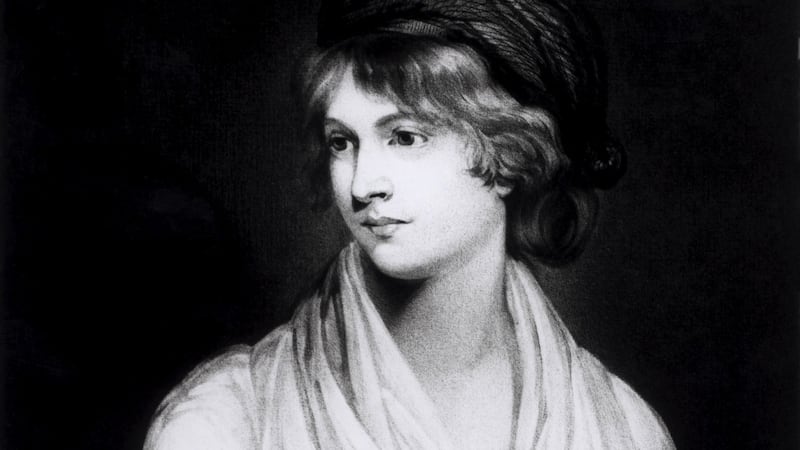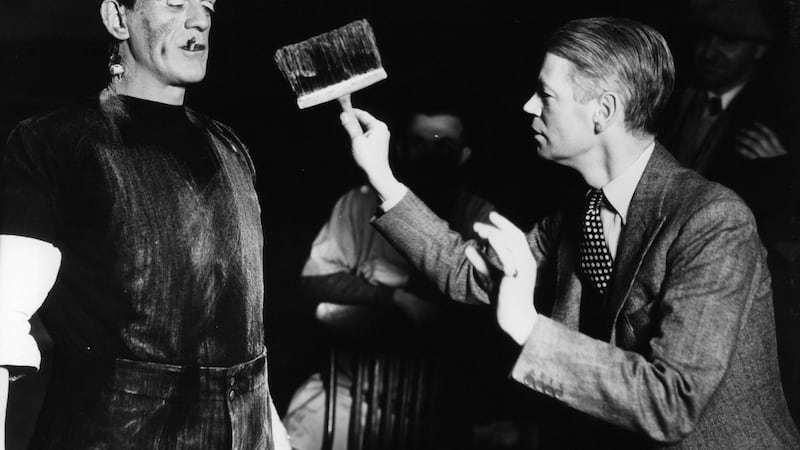Frankenstein, a novel which celebrates its 200th birthday in 2018, was conceived on a dark and stormy night. No, really. A dark and stormy night at the Villa Diodati, Lake Geneva, Switzerland in the year 1816. A 19-year-old woman, Mary Wollstonecraft Godwin – daughter of two of the 19th century’s foremost political thinkers, William Godwin and Mary Wollstonecraft – was staying there along with her lover, the poet Percy Bysshe Shelley, his good friend and poet Lord Byron and his pregnant mistress, Claire Clairmont (Mary’s step-sister), and Byron’s physician, John William Polidori.
Because of the cold and wintry weather associated with the lingering ash clouds following the volcanic eruption of Mount Tambora in Indonesia, 1816 became known as the “year without summer”. The group spent many days and evenings looking out at the sublime sight of rainstorms and lightning breaking over Lake Geneva.
To relieve the boredom of their confinement, they spent time telling spooky stories and eventually Byron proposed a writing competition of their own: “We will each write a ghost story,” he announced. “I busied myself to think of a story,” Mary wrote in her diary, “one which would speak to the mysterious fears of our nature and awaken thrilling horror.”

Finally, Mary struck upon a suitably thrilling and horrifying idea after taking part in a discussion with Byron, Polidori and Percy Shelley concerning the new science of galvanism. The group were fascinated by current debates about the creation of life using electricity, experiments in galvanism on animals and – more gruesomely – on executed criminals. Central to this discussion was Luigi Galvani, a popular Italian anatomy professor, who experimented on the effects of electricity upon dead frogs.
A more famous and horrifying application of galvanism occurred in 1803 with his nephew Giovanni Aldini’s public demonstration of the electro-stimulation technique upon deceased human limbs. This experiment was performed on an executed criminal at Newgate Prison in London. The criminal broadside, the Newgate Calendar, describes what happened when the galvanic process was used on the body:
“On the first application of the process to the face, the jaws of the deceased criminal began to quiver, and the adjoining muscles were horribly contorted, and one eye was actually opened. In the subsequent part of the process the right hand was raised and clenched, and the legs and thighs were set in motion.”
After this electrifying discussion on Galvani, Mary fell into a waking dream in which she saw “the pale student of unhallowed arts kneeling beside the thing he had put together” and felt the terror he felt as the hideous corpse he had reanimated with a “spark of life” stood beside his bed, “looking on him with yellow, watery, but speculative eyes”. The idea for the novel – and the monster – was finally born.
Mary frequently spoke of the conception of the novel as the conception of a child, calling it “my hideous progeny … the offspring of happy days”. This imagery of birth is significant: in late February 1815, the 17-year-old Mary had given birth to a premature and sick daughter, who died eight days later. “Find my baby dead,” Mary wrote in her diary of March 6th. “A miserable day.” After this, Mary dreamt incessantly about her dead child. Her journal of March 19th, 1815 presents a particularly gothic image of that dead baby: “Dream that my little baby came to life again, that it had only been cold, and that we rubbed it before the fire, and it lived. Awake and find no baby. I think about the little thing all day.”

This linked imagery of birth, death and pain infuses descriptions of Victor Frankenstein’s creation: his recollection for instance that to create his monster he had “so much time spent in painful labour”. His “pregnancy” and childbirth are obviously manifested by the existence of the huge being who emerges from what he describes as a “workshop of filthy creation”, but even the descriptive language of his creation myth is suggestive. Like Eve’s fall into guilty knowledge and Shelley’s own depressing experiences of maternity (only one of her five pregnancies survived into childhood), Victor’s entrance into the realm of parenthood is marked by a recognition of the interdependence of those complementary opposites, sex and death:
“It was on a dreary night of November that I beheld the accomplishment of my toils. With an anxiety that almost amounted to agony, I collected the instruments of life around me, that I might infuse a spark of being into the lifeless thing that lay at my feet. It was ready one in the morning; the rain pattered dismally against the panes, and my candle was nearly burnt out, when, by the glimmer of the half-extinguished light, I saw the dull yellow eye of the creature open; it breathed hard, and a convulsive motion agitated its limbs.”
Victor had arrogantly imagined how, after his child was created, “A new species would bless me as its creator and source … No father could claim the gratitude of his child so completely as I should deserve theirs.” What he finds instead, of course, is a mocking rebuke to his confident assumptions about his paternity:
“How can I describe my emotions at this catastrophe, or how delineate the wretch whom with such infinite pains and care I had endeavoured to form? His limbs were in proportion, and I had selected his features as beautiful. Beautiful! Great God! His yellow skin scarcely covered the work of muscles and arteries beneath; his hair was of a lustrous black, and flowing; his teeth of a pearly whiteness; but these luxuriances only formed a more horrid contrast with his watery eyes, that seemed almost of the same colour as the dun-white sockets in which they were set, his shrivelled complexion and straight black lips.”
The story of the creature’s birth, then, is on one hand a fantastical Gothic narrative, about the unnatural creation of life from electricity and graveyard charnel, of scientific hubris, of ethical and social folly, and of parental abandonment. On the other, it is a universal tale of the tragedy that ensues when science is not tempered by humanity. As the old joke goes, “Science can tell you how to clone a Tyrannosaurus Rex. Humanities can tell you why this might be a bad idea.” In that spirit, the MIT Press has just published a free online edition of the novel, “annotated for scientists, engineers, and creators of all kinds”.
After his creation is unleashed upon the world, Victor Frankenstein laments: “I had been the author of unalterable evils; and I lived in daily fear, lest the monster whom I had created should perpetrate some new wickedness.” The MIT edition here adds the footnote: “The remorse Victor expresses is reminiscent of J Robert Oppenheimer’s sentiments when he witnessed the unspeakable power of the atomic bomb… Scientists’ responsibility must be engaged before their creations are unleashed.”
”Hear my tale,” begs the unnamed creature at the centre of Mary Shelley’s Frankenstein, when he finally catches up with the hubristic young scientist who had created and abandoned him. The ensuing tale forces his creator to confront the dreadful consequences of ambition untethered from ethical responsibility. Two hundred years after the novel’s publication, the creature’s tale and that of his creator continues to fascinate and to proclaim its relevance.
For Aileen Douglas, Professor of English and Head of the School of English at Trinity College Dublin, Frankenstein is “among the very few novels that has attained the status of myth. In the 200 years since the book’s publication, its central issues of gender, creativity, and the relationships between nature and technology have become ever more pressing and urgent.”
And so, in 2018 it is more important than ever that not only literature students, but readers of all kinds revisit the debut work of the prodigious 19-year-old, a tale which combines tragedy, morality, social commentary and an examination of what it is to be human.
Frankenreads at Trinity
For this reason, Trinity College Dublin is proud to contribute to the international Frankenreads festival, which celebrates Shelley’s novel at 200 years old. To honour the importance of Frankenstein, the School of English is encouraging all college staff and students to read the novel, giving away 200 copies to spark a campus-wide discussion. On Halloween Day, the staff and students of the School of English will come together to read this thrilling novel from start to finish – this event is open to the public and all are warmly welcome to attend. On November 1st, the School of English is delighted to present a lecture by renowned international horror expert, Prof Darryl Jones, Dean of the Faculty of Arts, Humanities, and Social Sciences on Frankenstein at 200, followed by a (sadly sold-out) screening of the National Theatre Live 2011 sell-out production of Frankenstein, starring Benedict Cumberbatch as the Creature.
Further details of Trinity's Frankenreads events can be found at: frankenreadstrinity.wordpress.com or by following the hashtag #FrankenreadsTrinity on Twitter.
Dr Clare Clarke is assistant professor of English at Trinity College Dublin and co-ordinator of the university's contribution to the Frankenreads festival. She is an expert on 19th-century fiction, the author of the HRF Keating award-winning Shadows of Sherlock (2014) and the forthcoming The Rivals of Sherlock Holmes, to be published by Palgrave in 2019











